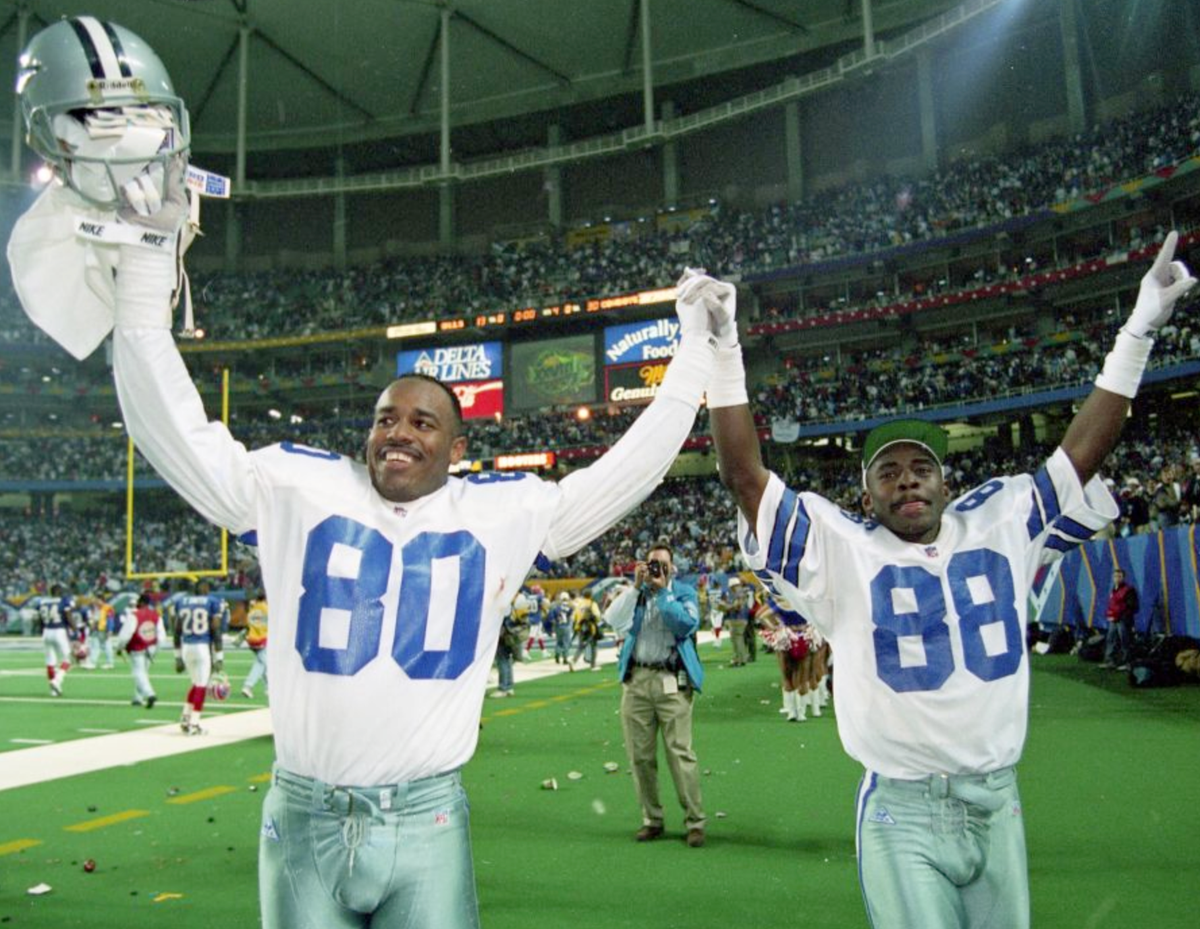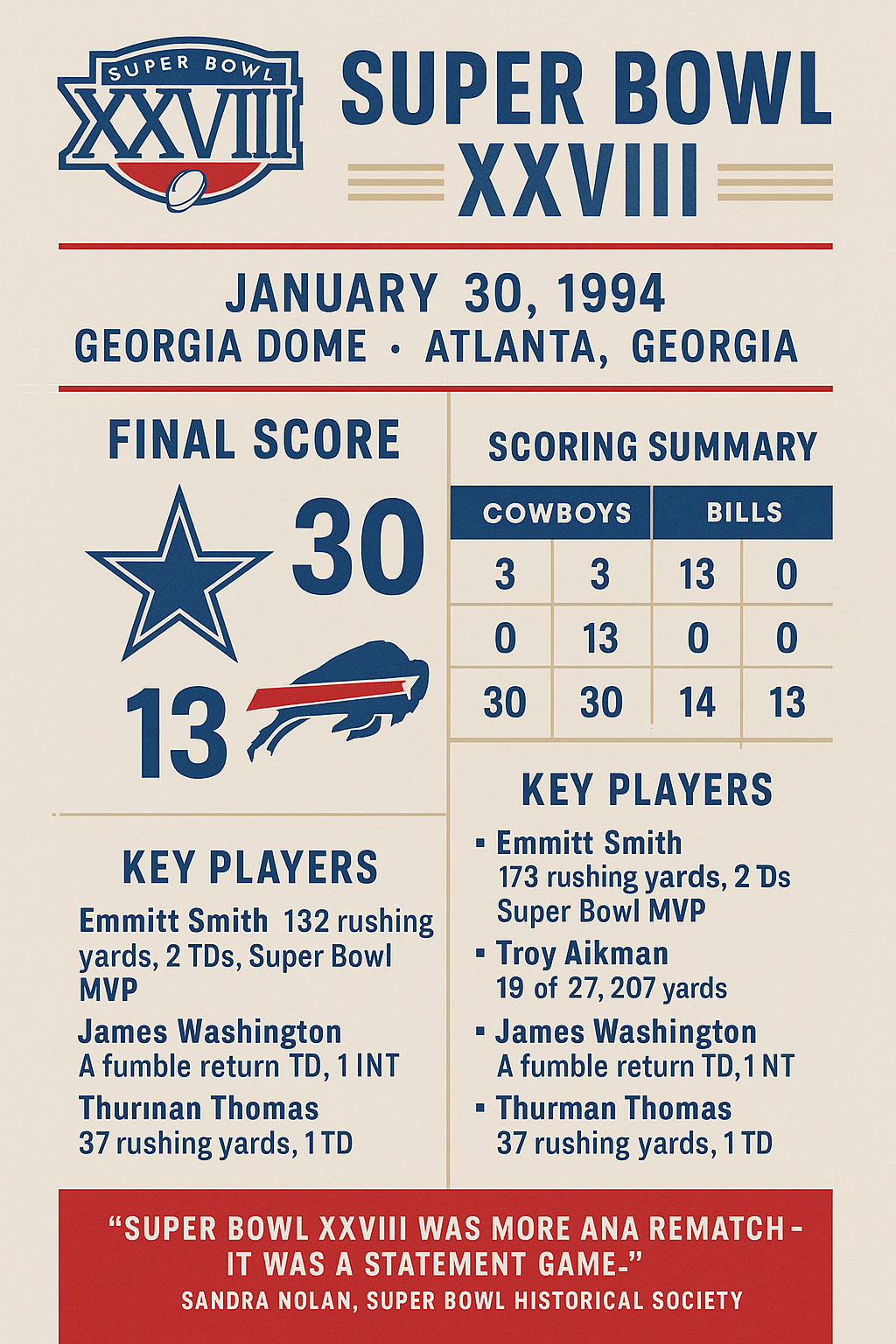Super Bowl XXVIII: Redemption in Atlanta and the Rise of a Dynasty

On January 30, 1994, the NFL returned to Atlanta, Georgia for a Super Bowl rematch unlike any other. Super Bowl XXVIII featured the Dallas Cowboys and the Buffalo Bills—a repeat of the previous year’s showdown. For Buffalo, it was one last shot at redemption after three straight Super Bowl heartbreaks. For Dallas, it was a chance to solidify their claim as the team of the 1990s. What unfolded at the Georgia Dome was a story of momentum, resilience, and the defining moment for one of the NFL’s greatest dynasties.
“Super Bowl XXVIII was more than a rematch—it was a statement game,” said Eleanor McKnight, senior curator at the Super Bowl Historical Society. “It marked the passing of the torch and the final chapter of Buffalo’s long, bittersweet journey.”
The Build-Up: A Tale of Two Storylines
The Buffalo Bills, coached by Marv Levy, were entering uncharted territory—becoming the first and only NFL team to reach the Super Bowl four consecutive times. Despite that historic feat, they had yet to lift the Lombardi Trophy. The pressure was immense. Quarterback Jim Kelly, running back Thurman Thomas, and wide receiver Andre Reed were future Hall of Famers, and this was their final chance to prove their greatness on the sport’s biggest stage.
On the other side, the Dallas Cowboys were navigating uncertainty. Although they were the defending champions, their 1993 season had been a grind. Running back Emmitt Smith held out for the first two games, and head coach Jimmy Johnson faced friction with team owner Jerry Jones. Nevertheless, Dallas stormed through the playoffs, and Smith won the NFL MVP, leading the league in rushing despite missing games.
This game was about legacy. For Buffalo, it was about rewriting theirs. For Dallas, it was about reinforcing theirs.
First Half: Buffalo’s Hope Burns Bright
The Bills came out strong. Early in the second quarter, Thurman Thomas ran for a 4-yard touchdown, and Steve Christie added a 54-yard field goal. Buffalo led 13–6 at halftime. Their defense was aggressive, their offense methodical. Most importantly, they kept the high-powered Cowboys offense out of the end zone.
It seemed, for a brief moment, that fate might finally smile on Buffalo.
But football is a game of halves—and Dallas was just getting started.
The Turning Point: One Play Changed Everything
The pivotal moment of the game came just seconds into the third quarter. On Buffalo’s first offensive play of the half, Thurman Thomas fumbled, and the ball was recovered by Dallas defensive back James Washington, who ran it back 46 yards for a touchdown.
The game was tied 13–13, and momentum violently shifted.
“That fumble return wasn’t just a touchdown—it was a cultural reset,” said Leroy Chamberlain, lead analyst at the Super Bowl Historical Society. “You could feel the air leave the Bills’ sideline. It was a gut punch from which they never recovered.”
From there, Dallas took over. The offensive line opened massive holes, and Emmitt Smith went to work.
Emmitt Smith: Power, Precision, Perfection
If Super Bowl XXVII was Troy Aikman’s night, then Super Bowl XXVIII belonged to Emmitt Smith.
The NFL MVP delivered a legendary performance, rushing for 132 yards and 2 touchdowns on 30 carries. His physical running style wore down the Bills’ defense, and his ability to churn out first downs kept the clock—and the game—under Dallas control.
In the fourth quarter, with Dallas leading by 10 and needing a dagger, Smith broke through a worn-down Buffalo front and sealed the game with a 1-yard touchdown run. For his performance, he was named Super Bowl MVP, a rare double honor in the same season.
His postgame comments were simple, yet chilling: “We expected to win. That’s just what we do.”
Final Score: Dallas 30, Buffalo 13
| Quarter | Dallas | Buffalo |
|---|---|---|
| 1st | 3 | 0 |
| 2nd | 3 | 13 |
| 3rd | 14 | 0 |
| 4th | 10 | 0 |
| Total | 30 | 13 |
After trailing at halftime, the Cowboys scored 24 unanswered points in the second half. Buffalo was shut out in both the third and fourth quarters.

Notable Stats
- Emmitt Smith: 132 rushing yards, 2 TDs (Super Bowl MVP)
- Troy Aikman: 19/27, 207 yards
- James Washington: 1 fumble return TD, 1 INT
- Thurman Thomas: 37 rushing yards, 1 TD, 1 costly fumble
- Jim Kelly: 260 passing yards, 0 TDs, 1 INT
Dallas finished with 276 rushing yards, dominating time of possession and physically overpowering Buffalo in the second half.
Coaching: Jimmy Johnson’s Final Act
This game would be Jimmy Johnson’s last Super Bowl with the Cowboys. The tension between him and Jerry Jones was already boiling over. Despite winning back-to-back championships—a feat not accomplished since the 1988–89 49ers—Johnson would resign just months later.
But he left behind a machine. The Cowboys were loaded with young stars, an elite offensive line, and a winning culture that would carry them to another Super Bowl (XXX) under Barry Switzer.
Buffalo’s Final Bow
For the Bills, this was the end of an era. Four straight Super Bowl appearances is one of the greatest accomplishments in NFL history, but four straight losses made the achievement bittersweet.
The core of the team—Kelly, Thomas, Reed, and Bruce Smith—would continue to play at a high level, but the franchise never reached the Super Bowl again. By the late 90s, age and salary cap challenges broke up the roster.
Still, their place in football history is secure.
“No team has ever climbed the AFC mountain four times in a row,” said McKnight. “They deserve to be remembered as warriors, not just runners-up.”
Cultural Moments and Broadcast Notes
- National Anthem: Sung by Natalie Cole.
- Halftime Show: Produced by Radio City Music Hall, themed “Rockin’ Country Sunday,” featuring Clint Black, Tanya Tucker, Travis Tritt, and The Judds.
- Broadcast Network: NBC, with Dick Enberg and Bob Trumpy on commentary.
- Viewership: Approx. 90 million U.S. viewers.
While the halftime show didn’t have the spectacle of Michael Jackson’s the year prior, it leaned into the host city’s southern flavor.
Legacy of Super Bowl XXVIII
Super Bowl XXVIII cemented several things:
- Dallas as a Dynasty: Back-to-back titles and three in four years (with Super Bowl XXX) validated their place among the greatest teams ever.
- Emmitt Smith’s Greatness: MVP of both the regular season and Super Bowl, Smith proved to be the cornerstone of the Cowboys’ dominance.
- Buffalo’s Heartbreak: Though mocked in popular media, the Bills’ four-peat remains unmatched. Their resilience and talent deserve far more admiration than derision.
- The Beginning of the End for Jimmy Johnson: Despite winning it all, off-the-field dynamics would shift the Cowboys’ leadership, changing the course of NFL history.
What If? Alternate Realities
Had Buffalo held on and won:
- Jim Kelly and Marv Levy’s legacies would be vastly different.
- The Bills would be seen as the most persistent success story in NFL history.
- The Cowboys might not have become the defining team of the 90s.
But that’s the drama of the Super Bowl. One fumble, one bounce, one moment—can alter legacies forever.
Conclusion: A Clash of Legacies
Super Bowl XXVIII was more than a repeat matchup. It was a clash between a team on the rise and a team nearing the end of its prime. Dallas, powered by youth and talent, seized control of the decade. Buffalo, full of heart and history, faced one final heartbreak.
“It was a changing of the guard,” said Chamberlain. “The Bills closed their Super Bowl book, and the Cowboys wrote another legendary chapter.”
From Thurman’s fumble to Emmitt’s dominance, the game had all the hallmarks of football’s most pivotal moments—drama, redemption, and the crowning of greatness.
